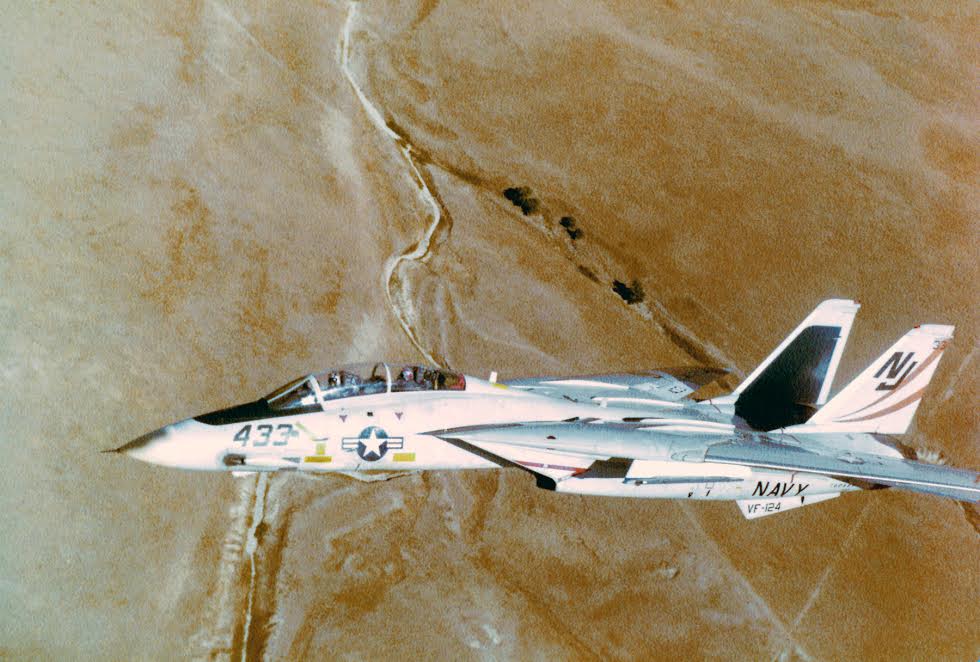“I looked at our rapidly increasing airspeed as we neared the end of the runway, and Crush yanked back on the stick to launch us into a steep nose-high climb,” Dave “Bio” Baranek, F-14 Tomcat RIO
After serving in F-14 squadrons as a Tomcat Radar Intercept Office (RIO) and in the prestigious TOPGUN training program, Dave “Bio” Baranek had a fruitful and fulfilling 20-year career in the Navy. He later was assigned to the Joint Chiefs of Staff and the US 7th Fleet. At one point, he commanded an F-14 Tomcat fighter squadron, responsible for fourteen aircraft valued at around $700 million and nearly 300 personnel in an F-14 Tomcat fighter squadron. With 2,499.7 flying hours and 688 carrier landings, he concluded his career as an F-14 Tomcat pilot.
The first of the American teen-series fighters, the Grumman F-14A Tomcat, was built to integrate air combat experience against MiG fighters in the Vietnam War. The F-14 was an excellent dogfighter, but the Tomcat’s ability to defend the fleet’s air space was what set it apart. To accomplish this mission, the aircraft was fitted with a powerful weapons system known as the AWG-9, which was able to support the AIM-54 Phoenix, which provided an unprecedented one-hundred-mile range and included a small onboard radar to guide itself to the target during the final phase of flight.

A RIO in the F-14’s back seat was necessary to maximize the AWG-9’s remarkable capabilities at different stages of the mission. Becoming a skilled F-14 Radar Intercept Officer, however, required a number of training stages, as Baranek explains in his book Before Topgun Days: The Making of a Jet Fighter Instructor.
Actually, after one year spent at Naval Air Station (NAS) Pensacola, future RIOs progressed to the Replacement Air Group (RAG), a squadron aimed at training naval aviators in specific types of aircraft.
Bio was assigned to Fighter Squadron (VF) 124 Gunfighters at NAS Miramar, the RAG for West Coast Tomcat Fleet squadrons, where he was trained to become an F-14 RIO. As he recalls in his book, among the first Tomcat flights, one stands out in his memories.

Not long after reaching RAG, Bio and his F-14 instructor pilot (IP), Ron “Crush” Gollhofer, took a cross-country flight to Denver. The flight, according to Baranek, took place over the course of a weekend. He, Crush, and their wingman arrived at Buckley Air National Guard Base, which is currently Buckley Air Force Base, which is located just outside Denver. They stayed at Gollhofer’s parents’ home and went to a Broncos football game, but, as Bio explains, the highlight of the trip was their departure Sunday evening, which was the start of his third Tomcat flight.
Once ready to take off, Crush told Bio to request an “unrestricted climb.” If this procedure were cleared, they would not have had to conform to the stepped climb profiles that accommodated a wide variety of traffic, from propeller-driven Cessnas to Boeing 737s, and instead would be able to use their fighter’s power and zoom quickly to altitude. Although it seemed completely reasonable for a fighter, it was just a request that would have to be made, granted or not. However, since air traffic around Buckley was light, the request was granted, and Buckley Tower cleared Bio and Crush to take off and climb unrestricted to 18,000 feet.
To better understand what an unrestricted climb looks like, Baranek takes us into the cockpit of their Tomcat, ready to go: “We took the runway. Crush pressed the brakes and ran the engines to military power, and the jet’s nose dipped. He wiped out the controls, throttled up to the afterburner, checked the instruments, and asked if I was ready to go. I was, and he released the brakes. The nose popped up, and we accelerated quickly. I called airspeeds, we rotated, and Crush raised the landing gear and leveled off to fly down the runway as we accelerated. In the evening darkness, I was keenly aware of the bright blue-white glow of flame from our engines forty feet behind me. Lights on hangars and buildings streaked by in my peripheral vision. I looked at our rapidly increasing airspeed as we neared the end of the runway, and Crush yanked back on the stick to launch us into a steep, nose-high climb. ‘Buckley Tower, Navy November Juliet 426, airborne, switching Departure.’ I tried to sound like I belonged here, but I’m sure the controllers in the tower knew that I was both new and loving it. Since Buckley is about 5,600 feet above sea level, it took quite a bit less than thirty seconds for us to reach our assigned altitude of 18,000 feet. Crush smoothly leveled off while I rapidly switched through the Departure Control frequency and contacted Denver Center. We were cleared to climb to a higher altitude and start the route back to Miramar. I was storing all the sensations and images in my long-term memory and looking forward to a nice flight home when Crush said, ‘Okay, get some contacts on the radar.’”
Photos used with permission of author Dave “Bio” Baranek

